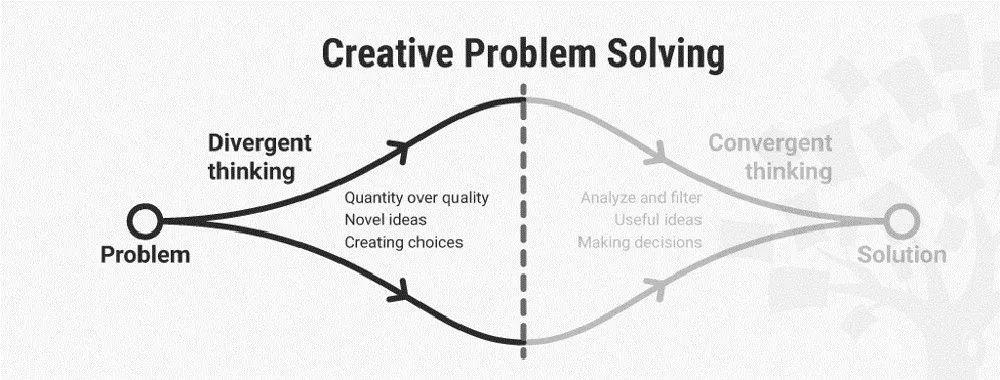A look at how UX design can elevate or hinder the experience of playing video games, through a few examples.
Creativity, optionality, and avoiding pre-mature convergence

If you’ve ever been part of a design thinking workshop or any similar ideation activities, you’ll be familiar with the level of importance ‘creativity and innovation’ places on divergent thinking. It’s long been seen as a necessary capability for producing novel ideas.

Divergent thinking is defined as our ability to generate potential solutions or dream up possible futures (often in a non-linear way). It’s the function that enables us to come up with new ideas.
In 1950, J. P. Guilford coined the term in a paper aptly titled ‘Creativity’ as a challenge to how we had historically viewed intelligence, but it has since influenced many other branches of cognitive psychology — including decision making.
Our capacity for divergent thinking allows us to envision many possible futures in which we assume a particular outcome. It allows us to construct hypotheses and ask ‘what if?’ questions — so it’s no surprise that this is an incredibly important function when it comes to strategic decision-making. A strong exploration of the problem space to generate potential choices is arguably more than half the battle.
In recent studies, neuroimaging shows that the part of the brain activated during divergent thinking is what’s called the ‘Default Mode Network’ (DMN). This is the same part of the brain we use when we are daydreaming or ‘mind-wandering’. These studies surprised scientists who previously thought the brain was only highly active during focused tasks when logical and executive functions are working.
This particular function of the brain is active when we’re introspective (not thinking about the outside world) and when attributing mental states (like beliefs, intents, desires, and emotions) to ourselves and others. It’s also believed to be instrumental in episodic future thinking, which we covered in a previous post on ‘mental time travel’.
It’s interesting to note that when we’re actively on-task or our attention is on the outside world in some capacity, the DMN is not functioning. This means when we’re engaged in a meeting, scrolling social feeds, or reading emails, we’re inhibiting divergent thought.
“Enlightenments, like accidents, happen only to prepared minds.”
— Herbert A. Simon
Unfortunately, there isn’t much time in the modern day (if any time at all) that supports true divergent thought, but fostering divergent thinking helps us overcome many of the convergence-driven cognitive biases that drive groupthink.
So aside from what Johann Hari calls the ‘attention crisis’, why do we have difficulty with divergent thinking and considering a wider set of options and perspectives?
Divergence Inhibitors
Guilford’s research suggested that an individual’s capacity for divergent thinking varied greatly, but even though it doesn’t come naturally to everyone, it can be systematically encouraged.
It’s worth noting that though most divergent thinking tests aim to measure ‘creativity’, this isn’t a measure of intelligence. In fact, some studies suggest the two are completely unrelated while others suggest a modest relation (at most).
It’s okay to not be a naturally divergent thinker — many are not. In fact, it’s important to strike a balance in the decision making process — it can be equally detrimental to diverge too long as it is to converge too early.
More often than not, we converge too quickly (pre-convergence) — meaning we:
- Zero in on their initial idea(s)
- Dive right into planning
- Fail to challenge initial assumptions and beliefs
- Accept data/information instead of interrogating it
- Don’t ask ‘why’
This is often done with the best of intentions. Most of us genuinely want what’s best, but of course, this is within the constraints of our own particular perceptions. We do this for various reasons:
- Anchoring Bias: We compare everything to reference points, and the first reference point we receive is often very strong. This means our first ideas are difficult to dethrone.
- Confirmation Bias: It’s easier to confirm our existing beliefs and assumptions than it is to break them, so we tend to ignore other potential options.
- Belief Bias: We tend to judge options based on how believable they are, rather than their validity — this means we’re far more likely to find options plausible that fit our existing narrative.
- Status Quo Bias: We have a general preference for maintaining our existing situation over making changes. We don’t like to rock the boat.
- Availability Heuristic: We tend to believe we have far more information than we actually do — and believe it’s more accurate than it really is.
One of the more interesting inhibitors is the actual inhibition function in our brains. This area of the brain is responsible for managing focus and reducing distraction.
The inhibition function has a major impact on our capacity for divergent thinking, but not only due to focus. It controls what information we have access to by measuring the strength of the connection between information and the initial concept — then filters accordingly:
“Since inhibition serves the function of keeping weakly related information out of working memory, the impairment of this function would activate a greater number of concepts in working memory with many of them only weakly related to the initial concept.”
Much of the current research around divergent thinking is exploring the connection between creativity and logic. For example, the same study suggests that we may be using parts of the executive function for high-performance divergent thinking.
Though much of divergent thinking and the cognitive functions that drive it are not well understood, we do know that this uniquely human ability to imagine possible futures with relatively little information is an important capability for strategic thinking.
Understanding how to elicit this function, both in individuals and in teams, can be an incredibly powerful tool.
“The ability to perceive or think differently is more important than the knowledge gained.”
— David Bohm
Side Notes:
This may remind you of the classic ‘Left Brain, Right Brain’ theory that suggested different sides of the brain are used for creative vs logical tasks. Though it’s true that different sides of the brain support the motor functions of the opposite side, the distinction between creative and logical functions has long been debunked.
An interesting find: a correlation between eye blinking and divergent thought 👀
There a few studies on the relationship between divergent thinking and spontaneous eye blink rate (sEBR). And yes, a high eye blink rate was an indicator of strong divergent thinking performance and weak convergent thinking performance.
Other studies also show a correlation between unrestricted movement like walking and divergent thinking performance.
Tools that facilitate divergent thinking
Techniques that claim to foster divergent thinking aren’t hard to find, but it seems that true divergent thinking is an individual activity, not a group activity — groups tend to encourage convergence.
Divergent thinking itself is an introspective mechanism, so any techniques that claim ‘group brainstorming’ as a method for fostering divergent thought may actually be inhibiting it.
An effective way to encourage divergent thought is to have groups run through a thought experiment individually and then return to share with the broader group.
Here are a few examples of techniques that may be lesser known, but provide different ways to encourage divergent thinking:
- The Vanishing Options Test by Chip & Dan Heath: A thought experiment that removes the existing options and forces the consideration of new options
- Opportunity Solution Trees by Theresa Torres: A method for surfacing the opportunity a solution is attempting to address and then asking probing questions like, “How else might we…” to expand the possible choices.
- Design Thinking made popular by IDEO: A broad methodology for focusing on explorative and iterative processes as an approach to problem-solving. Design Thinking places an emphasis on divergent thinking
- SCAMPER: Walks through a series of questions based on similar methodologies to the divergent thinking tests used in many of these studies (e.g. how can you adapt, modify or put something to new use).
- Six Thinking Hats by Edward de Bono: A simple, yet elegant thought experiment that forces people to look through the lens of new perspectives
Again, though these create a helpful framework for considering new options, much of the power here is lost when done in groups (even though it’s tempting and feels good). It’s best to have individuals think independently before collaborating in groups.
This post was originally published on 🔮 The Uncertainty Project — a resource on tools and techniques for strategic decision making and navigating uncertainty.
Tools to facilitate divergent thinking was originally published in UX Collective on Medium, where people are continuing the conversation by highlighting and responding to this story.


Leave a Reply